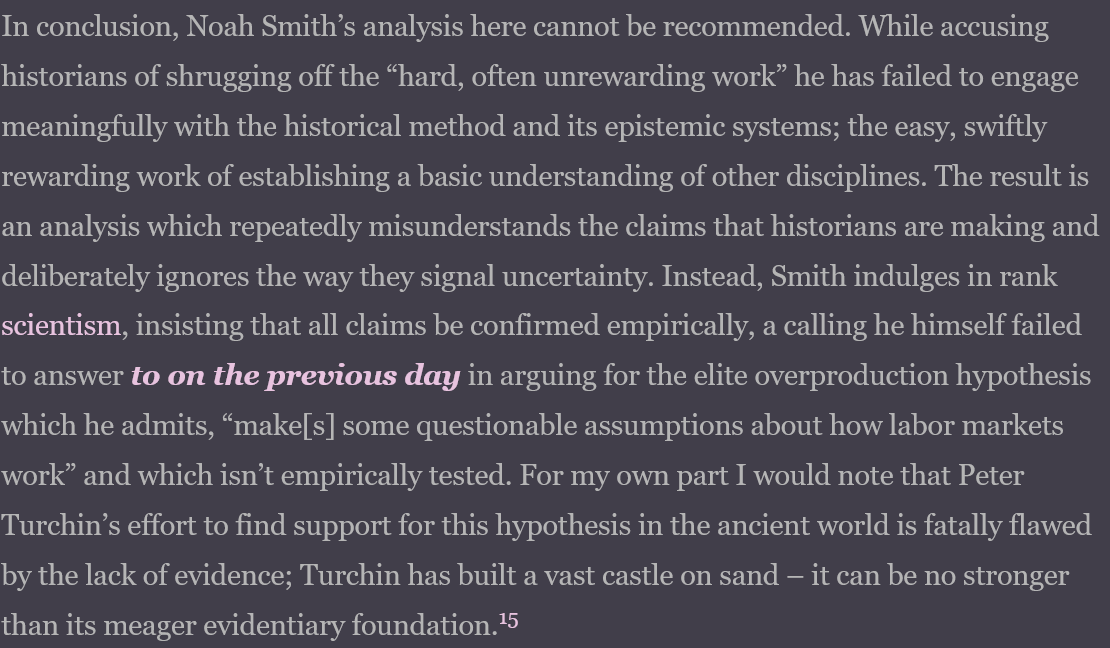Which Preindustrial Society was the Most Energy-Rich?
1. Thanks to all who proposed their answers here, as well as commenters on my blog.
2. Remember that I formulated the questions so that the answer must be expressed as W (Watts) per capita. W=J/s
peterturchin.com/cliodynamica/q…
1. Thanks to all who proposed their answers here, as well as commenters on my blog.
2. Remember that I formulated the questions so that the answer must be expressed as W (Watts) per capita. W=J/s
peterturchin.com/cliodynamica/q…
3. I now have three contenders, one that was a surprise for me, two that I had in mind when asked the question.
4. Let's start with the surprising one: hinter-gatherers burning grass-lands or brush-lands to create habitat suitable for their life-styles.
4. Let's start with the surprising one: hinter-gatherers burning grass-lands or brush-lands to create habitat suitable for their life-styles.
5. After initial resistance, I decided that this is a valid entry into the race. These people used energy to modify environment to suit their needs. Is that different from people using muscle power to cut forests for agriculture, or a modern farmer using bulldozers to clear land?
6. To quantify it we would need to figure out what area was burned, what was energy density (standing plant biomass per unit area), and what was the size of the foraging group (to get to per capita terms).
7. The problem for this contender is that such habitat modification only happened once a year. So once we divide by 365 and the number of foragers in the band, we may not get an impressive number in Wpc (Watts per capita). But let's see.
8. The next contender is a society in a harsh (cold) climate. People here proposed the Norse, but actually my homeland (Russia, specifically around Moscow) has a more energy demanding climate (because it is continental).
9. Even a well constructed (insulated) house in Moscow region require 5-6 cubic meters of firewood (that's nearly two cords, for you North Americans) to keep it warm through winter.
10. That's 3,000 kg of wood (a lower estimate) at 20 MJ/kg. Dividing this by 30 mln seconds/year and four people (a typical household) we have 500 Wpc. Now we are talking real numbers!
Plus energy needed for steel tools, pottery, transportation, plowing. We have a real contender
Plus energy needed for steel tools, pottery, transportation, plowing. We have a real contender
11. Now to the final contender (and my answer to Ian): the Mongols!
Let's look at the Mongols just before they went on the rampage through Eurasia under Chinggis Khan.
Let's look at the Mongols just before they went on the rampage through Eurasia under Chinggis Khan.
12. Nomadic armies were different from your usual idea of a medieval army. They were followed by huge herds of horses. Each Mongol needed 3-4 horses for effective military operations, because horses tire faster than their riders, and need time to recover after being ridden hard.
13. 1 horsepower is c.750 W. At three horses per warrior and rounding down we have 2 kWpc. That's an awesome amount of power by pre-industrial standards. No wonder the Mongols conquered as far as they cared! Their only defeat was at the hands of Mamluks, also steppe warriors.
14. Of course, warriors were only a part of the Mongol society. But we also need to add other transport animals o horses, as Mongols also herded camels and yaks, depending on the environment. They also had a well-developed metallurgy.
15. But they didn't spend a lot on heating (firewood is hard to come by in the steppe, although they had a lot of animal dung). And on pottery. Still, just due to their vast horsepower, their energy use per capita should be way up there.
16. Once we do the numbers, I expect that Russians and Mongols will share the first two positions as societies that were the most energy rich per capita.
17. Iron-making capacity of Sung China is really impressive, but gets diluted by the population numbers (90 mln).
17. Iron-making capacity of Sung China is really impressive, but gets diluted by the population numbers (90 mln).
18. These are back of the napkin calculations, and I welcome your constructive critique! The requirement, however, is that we use the same currency -- Wpc. Please don't tell me about the intellectual brilliancy of your favorite civilization (wonderful, but that's not the point).
===== End of thread =====
• • •
Missing some Tweet in this thread? You can try to
force a refresh








